We may be living in a golden age for cat owners looking for fancy litter boxes or designer perches, but choosing the right food for our feline friends can still be surprisingly difficult, due to confusing labels and the lack of transparency required of food companies. "Owners are trained to look at the ingredient list as the only way to judge the quality of pet food," says Martha G. Cline, a certified veterinary nutritionist at Red Bank Veterinary Hospital in New Jersey. "But it doesn't tell you anything about the quality of that ingredient or the nutrient provided in that ingredient." Jennifer Coates, a veterinary expert at Chewy, says cats need more protein than many other species and stresses that the protein "should be sourced from animals. But aside from noting the kind and amount of any cat food's animal protein, the labels on many brands won't give you much useful information, according to the professionals we spoke with.
Fortunately there are a few resources out there that can help you better choose your cat food. "Probably the most important part when you're buying [food] for your pet is looking for the nutritional-adequacy statement and making sure it's for the appropriate life stage for your pet," says Cline. All pet food should have a nutritional-advocacy statement from the Association of American Feed Control Officials (AAFCO) noting whether they meet the standards for growth (good for kittens), adult maintenance (for maintaining a healthy weight), or all life stages (any age). Several vets we spoke with also pointed us to the World Small Animal Veterinary Association (WSAVA)'s tool kit with questions pet owners should ask when they're shopping for cat food, including about the percentages of protein, fat, and carbohydrates in a particular food (this data isn't required on labels). After asking many of these questions herself, veterinarian Lisa Pierson compiled a thorough chart of the nutrient profile for hundreds of cat-food flavors. As for what to look for on that chart, Jennifer Berg, founder of Tribeca Veterinary Wellness, says “more protein than fat, and then very little of any kind of carbohydrate is what we feel is probably ideal." She advises looking for food that's at least 45 percent protein and less than 10 percent carbohydrates, noting that nutrient profiles can vary widely between flavors of the same cat-food brand, so be sure to check the chart for each individual flavor.
With obesity and related conditions like diabetes on the rise among cats, you'll also want to make sure your kitty isn't eating too much. To maintain a healthy weight for your cat, vets suggest canned (or wet) food, which is less calorically dense than dry food, and feeding two to three times per day on a regular schedule, rather than just leaving the food out. "Kitties should not be grazing all day, every day," says veterinarian Karen Becker. "We cannot leave a bowl of food out and expect them to maintain their body weight." Some vets we spoke with say it's fine to feed cats a mix of dry and canned food, but the consensus seems to be swinging in favor of wet food, not only because it contains fewer calories but because it's richer in moisture (cats don't have much of natural thirst drive, so it's important to ensure that they're getting enough water from their food). With the consensus on wet over dry food in mind, below are the best canned foods you can feed your feline friend, based on our seven vets' recommendations. And if you also own a dog, or prefer four-legged friends of the canine variety, be sure to check out our picks for the best vet-recommended dog foods.
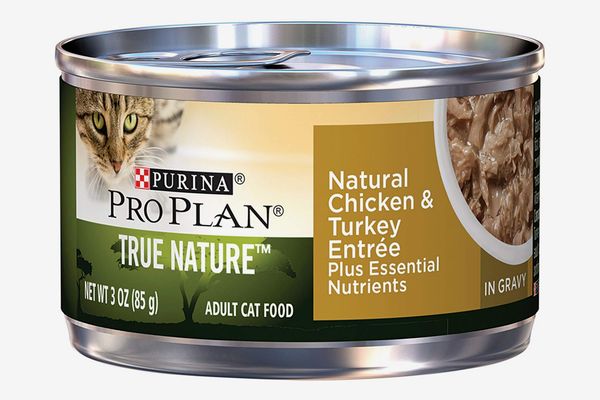
Purina Pro Plan True Nature Natural Chicken & Turkey Entree in Gravy Canned Cat Food
Cats generally require 200 to 250 calories per day, but this varies based on frame size, activity level, and whether your cat needs to lose or gain weight. Megan Shepherd, a veterinary nutritionist at the Virginia Maryland College of Veterinary Medicine at Virginia Tech, advises checking with your veterinarian for more specific guidance and consulting this body-condition score chart to see if your cat is under- or overweight. Because Purina employs full-time veterinary nutritionists and invests heavily in research and development, it's a favorite brand of veterinarians like Cori Blair of Feline Health (a cats-only practice in New York City) and Valerie Parker, an associate professor of small-animal internal medicine and nutrition at Ohio State University's College of Veterinary Medicine. "The meats in gravy are generally what I feed my cats," says Blair, who explains that these flavors are usually palatable to most cats, which can help if you're transitioning from dry to canned food. According to Pierson's chart, this formula contains 57 percent protein, 37 percent fat, and 6 percent carbohydrates, so it meets the standards Berg recommends for healthy adult felines.
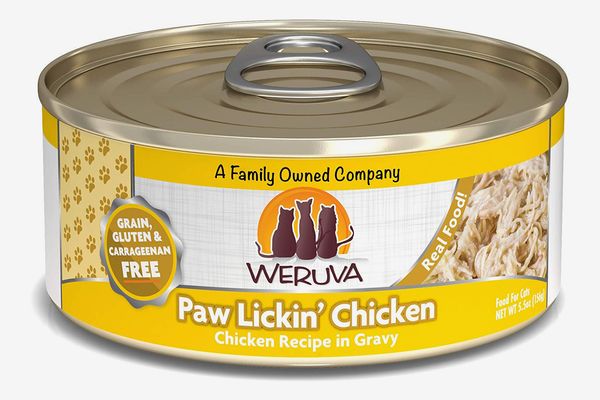
Weruva Paw Lickin Chicken in Gravy Grain-Free Canned Cat Food
Berg points out that this chicken-in-gravy flavor from Weruva also hits her nutritional requirements. Although it's labeled as "grain-free," vets are wary of this marketing term that doesn't necessarily mean the food is low in carbs. “If you think about grain-free pet food, they're replacing those things with starches or a potato or a legume," explains Cline, "and if the whole idea in the marketing of feeding grain-free food is because it's not part of the natural diet of a cat, you just replaced it with other things that are also not part of the natural diet of the cat either." This Weruva food is formulated with potato starch but contains only 3 percent carbohydrates (along with 65 percent protein and 32 percent fat), so if your cat likes the taste, it's still a healthy choice.
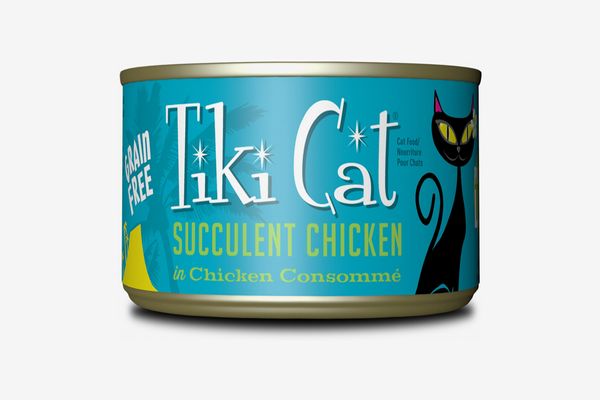
Tiki Cat Puka Puka Luau Succulent Chicken in Chicken Consomme Grain-Free Canned Cat Food
If you browse Pierson's list, you'll see that Tiki Cat offers many healthy foods that are high in protein and low in carbs. Lots of Tiki Cat food is fish-flavored, which is extremely attractive to cats because of its salty taste, but vets like Berg and Becker actually discourage feeding cats fish because of its high iodine content, which could lead to hyperthyroidism. Fortunately, this all-chicken flavor is just as nutritious, with 77 percent protein, 23 percent fat, and no carbohydrates.
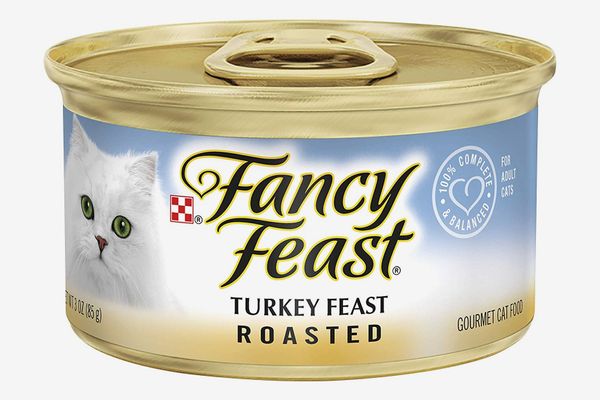
Fancy Feast Roasted Turkey Feast Canned Cat Food
There's nothing wrong with saving money on cat food as long as you're picking a food that's nutritionally sound. "A lot of people will say Fancy Feast is kind of the 'McDonald's for cats,' but it's actually not the case," says Berg. "Plenty of the Fancy Feast [formulas] are actually quite high in protein and very low in carbohydrates." With 56 percent protein, 38 percent fat, and only 6 percent carbs, this turkey flavor fits the bill. Since canned food is less calorically dense than dry food, feeding with it is generally more expensive, but you'll likely save on medical care in the long term.
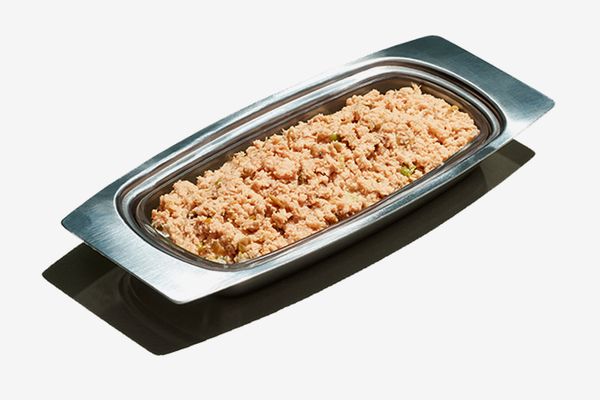
Smalls Turkey

NomNomNow Chicken Chow-Meow
To further maximize your cat's nutrition, Becker recommends looking for human-grade food, meaning it contains meat that has been approved by the USDA for human consumption. Most pet food is made from feed-grade meat, which, according to Becker, "means it's lesser quality with potentially less-than-healthy ingredients." Although human-grade pet food is generally more expensive and more difficult to find, some brands are starting to offer it for discerning cat owners. Small and NomNomNow are two relatively new, direct-to-consumer brands that use all-human-grade ingredients and formulate their food to cats' ideal nutritional needs. If you've thought about feeding your cat a fresh- or raw-food diet but are concerned about food safety or convenience, a preservative-free, human-grade, commercial food is the next best thing, according to Becker. (I've given my cat a sample of NomNomNow, and she was a big fan.) Prices vary, as both companies offer customized portion sizes based on your cat's age and weight.
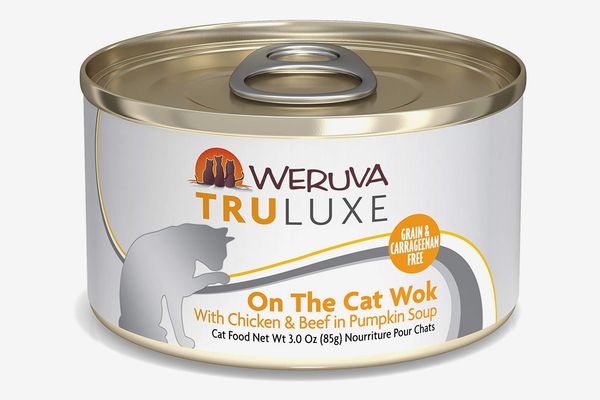
Weruva Truluxe On The Cat Wok with Chicken & Beef in Pumpkin Soup Grain-Free Canned Cat Food
If you look at Pierson's chart, you'll see that the fourth column tracks how much phosphorus is in each food. This might not be the first thing you look for when shopping for your own food, but this mineral is actually very important in cat health. Berg says limiting phosphorus is crucial for senior cats, as too much of it can cause or worsen kidney disease, a common problem among older cats. Previously, vets would advise reducing protein in senior cats' diets, but Berg contends that protein - and moisture - levels should stay high while reducing phosphorus. "It's just that the phosphorus tends to go up as the protein goes up," she says. "But there are some proteins that are higher in phosphorus than others. So while there's no AAFCO standard for senior cats, a low-phosphorus food (Berg says to try to stay under 200 milligrams per 100 calories) could benefit your cat that is ten years old or older. This nutritionally balanced Weruva food contains only 163 milligrams of phosphorus per 100 calories.

Royal Canin Mother & Babycat Ultra-Soft Mousse in Sauce Wet Cat Food
If you're buying food for a kitten, make sure to look for the AAFCO nutritional-adequacy statement for growth. "Because kittens are growing and developing, they require more calories than adult cats do on a per-pound basis," says Coates. "Kitten foods are generally higher in fat than are foods designed for adults to provide them with these extra calories." Blair and Parker are both fans of Royal Canin, and the brand's just-for-kittens food is packed with protein and fortified with all the vitamins and minerals the littlest kitties need to thrive.
:max_bytes(150000):strip_icc():format(webp)/what-horses-eat-that-keep-them-healthy-1886504-FINAL-5ba8dd3746e0fb0025eb2cb4.png)
:max_bytes(150000):strip_icc():format(webp)/horse-eye-resized-56a4dbf03df78cf77284fe95.jpg)
:max_bytes(150000):strip_icc():format(webp)/Horse-grooming-GettyImages-495726400-5876f27d5f9b584db351222e.jpg)
:max_bytes(150000):strip_icc():format(webp)/close-up-of-hand-holding-parrot-705172843-5b52bc4ec9e77c0037b6e5a4.jpg)
:max_bytes(150000):strip_icc():format(webp)/GettyImages-579524112-5c77331146e0fb000140a3a6.jpg)
:max_bytes(150000):strip_icc():format(webp)/budgerigarsonrope-331834_1920-5b628213c9e77c00255b32bc.jpg)
:max_bytes(150000):strip_icc():format(webp)/GettyImages-106887241-58325bc03df78c6f6a9a2ed2.jpg)
:max_bytes(150000):strip_icc():format(webp)/GettyImages-878015800-06106157c9d34a2081db4abcae8699b1.jpg)
:max_bytes(150000):strip_icc():format(webp)/hungry-cat-57b72fac5f9b58cdfda11a62.jpg)


:max_bytes(150000):strip_icc():format(webp)/4374985466_59c7f6545b_o-8b4f24f2f3e544349fe537fde58cfad0.jpg)
:max_bytes(150000):strip_icc():format(webp)/GettyImages-9298737261-500c5a2fba4248f89d1c17a33bf438f7.jpg)
:max_bytes(150000):strip_icc():format(webp)/veterinarian-and-owners-examining-dog-in-vet-s-surgery-164853745-dbecbdb691d549d79487d84356920cf4.jpg)